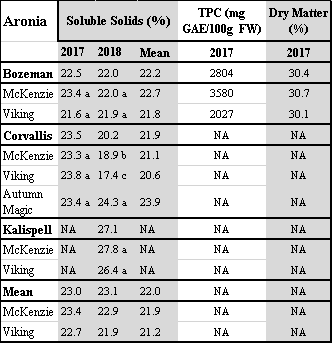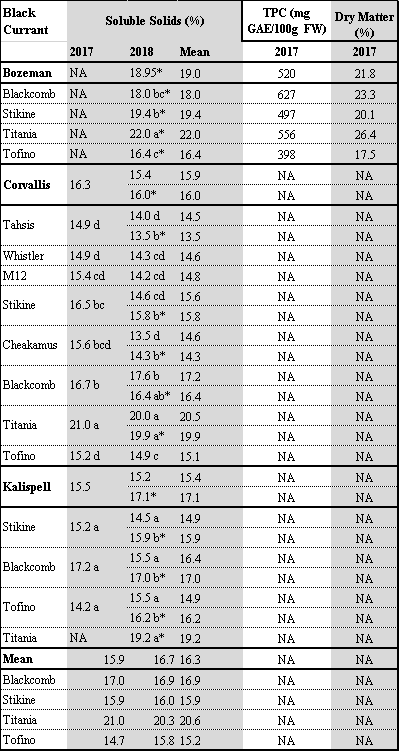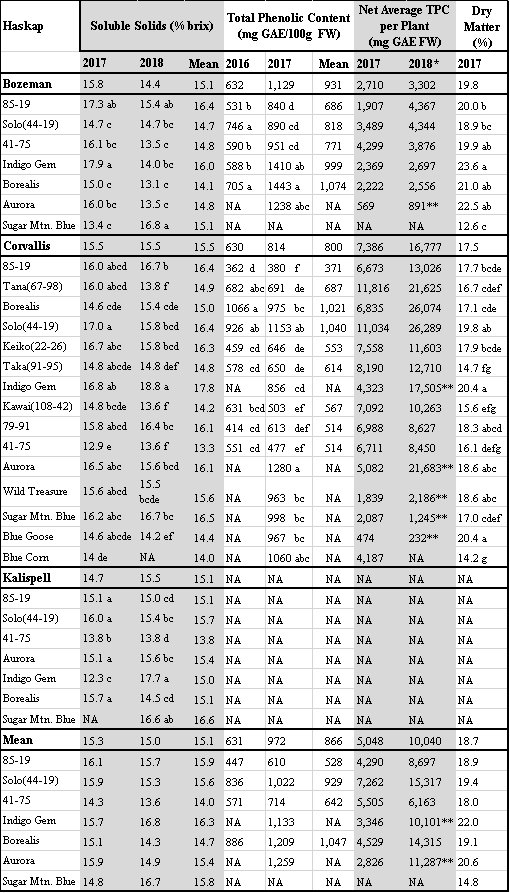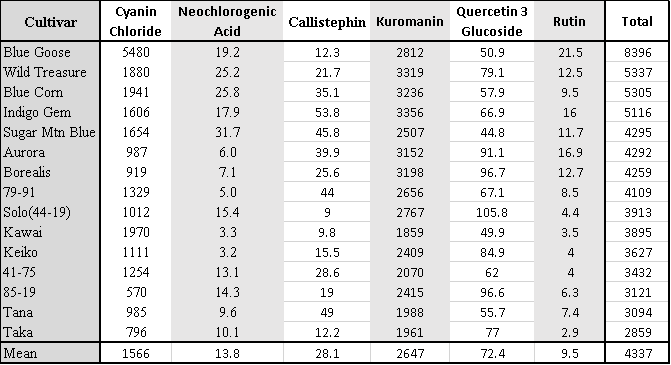Final report for GW18-050
Project Information
Intro
A fruit evaluation project is being conducted at three locations in Montana: MSU Bozeman Horticulture Farm, The MSU Western Agriculture Research Center (WARC) in Corvallis, and Flathead Valley Community College in Kalispell. The project was established in 2015 by a Specialty Crop Block Grant, with ongoing support from that program to continue fruit production, storage, marketing, and consumer acceptance. The purpose of the trial is to evaluate cultivars of 6 fruit species commonly known as Aronia, Black and Red Currants, Dwarf Sour Cherry, Juneberry, and Haskap. The trial includes between 2 and 8 cultivars per species at all sites, with extra varieties trialed in Corvallis. The trial aims to measure the suitability of different cultivars to the Montana environment. Targeted research includes monitoring; yield and quality factors, cold hardiness and survival, pest and disease incidence, and growth phenology. Fruit quality was the focus of this SARE-funded component of the larger fruit evaluation project.
These fruits are believed to have nutritive qualities comparable to other contemporary super-fruits, as well as other qualities such as dark pigmentats which are proving attractive to food and beverage production entities for their health food marketing potential and natural colorant uses.
Despite increased interest in these species, there is little data about the specific quality parameters of these crops. Establishing these details for producers will allow them to make best practice decisions regarding location siting and preparation, fertilization, integrated pest and disease management. Furthermore, analysis of the nutritional quality of these cultivars will allow producers and processors to select for fruit with targeted nutritional properties.
The intent of this project is to quantify and report the phytonutrient contents of these unique fruit. Specifically, the fruit were measured for phenolic content and compounds. This research complements other research on fruit quality by the author, and the overall project.
Research Approach
Fruit from Bozeman and Corvallis research plantings, of multiple species and cultivars but primarily haskap, were collected for analysis in 2016 and 2017. Haskap provided the most samples as it was the fastest maturing species. The fruit were analyzed for Total Phenolic Content in the MSU Food and Health Lab under direction and mentorship of Dr. Selena Ahmed. In 2019 the fruit extracts were analyzed via UPHLC analysis under the guidance of Dr. Ganesh Bala, in the MSU Mass Spec Facility.
Education Approach
The educational approach utilized by the Cold Hardy Fruit Program in Montana has largely been one of a hands on, learning farm approach. Under this philosophy, the public and other interested parties are invited to tour the research orchards. This allows an in-depth introduction to the many elements of successful orchard operation, and allows a tailored approach to each group's interests and experience levels. Such varying stakeholder demonstrations have included master gardeners, children, indigenous students, aspiring and established orchardists, and students of MSU Bozeman and Flathead Valley Community College as well as attendees of annual public field days at the Bozeman and Corvallis sites.
The fruit have been included in the CSA offerings of the Bozeman Hort Farm's Towne's Harvest Garden, and Corvallis Loyal-to-Local multi-farm CSA, increasing exposure to stakeholders who might otherwise not have experienced such novel offerings.
Further outreach has occurred with regular presentations by associated individuals to interested stakeholders such as the Flathead Valley Cherry association, master gardeners conferences and the Montana Organic Association.
Both an extension MontGuide and a journal article of results are nearing completion.
Additionally, a web page with information about the fruit and results is maintained by the Western Agricultural Research Center at http://agresearch.montana.edu/warc/index.html.
Research Conclusions
Total Phenolic Conent
Total phenolic content (TPC) was measured extensively among haskap cultivars and some samples were procured of black currant, aronia and dwarf sour cherry. Results in Montana were largely equal to or superior to reports from other cultivar trials, supporting a hypothesis that the cold climate and high elevations of Montana might produce fruit with superior qualities to more favorable cropping environments.
Aronia
Aronia TPC in Bozeman of two cultiars was found to range 2000 to 3600, averaging 2800 mg per 100 grams of fresh fruit. The cultivar McKenzie produced the highest TPC.
Black Currant
Black Currant TPC in Bozeman of four cultivars was found to range 398 to 677 mg, averaging 520 mg per 100 grams of fresh fruit. The variety Blackcomb was observed to produced the highest TPC.
Dwarf Sour Cherry
A single dwarf sour cherry sample was analyzed from Bozeman in 2017. This sample of the cultivar Carmine Jewel found a TPC level of 570 mg per 100 grams of fresh fruit. This data was very preliminary but suggested that Dwarf Sour Cherry cultivars, despite their dark coloration, do not contain TPC levels higher than other sour cherry fruit.
Haskap
Haskap TPC was measured for 2016 and 2017 fruit from both Corvallis and Bozeman.
On average, haskap cultivars produced 866 milligrams of TPC per 100 grams of fresh fruit, with a range of 450 to 1250 mg. The highest values were observed in Borealis, Solo, Aurora and Indigo Gem.
When looking at the cultivars on the combined basis of yield and TPC, the cultivars which produce the largest total yield of phenolic content include Borealis, Solo, Aurora, and Tana.
Phenolic Compounds
Phenolic compounds of 70 haskap cultivar samples were analyzed for 6 different phenolic compounds via UPHLC in 2019. Despite multiple analysis runs under close mentorship of the lab professor, half of the compounds results did not correspond with published results. Regardless, concentrations were uniform across cultivars and sites and may still be used in comparison of cultivars.
The compounds analyzed consisted of three anthocyanins; cyanin chloride, callistephin chloride, and kuromanic acid, two flavonoids; quercetin 3 glucoside and rutin, and a phenolic acid; neochlorogenic acid.
Cultivars from Oregon and Saskatchewan tended towards lower production of cyanin chloride, neochlorogenic acid, rutin and kuromanin than the low yielding Sugar Mountain Blue and Czech cultivars trialed in Corvallis.
In contrast, quercetin 3 glucoside was more prevalent in high yielding cultivars.
Across sites, Indigo Gem produced the highest concentrations of observed compounds, with Sugar Mountain Blue following closely. The lowest total concentrations were observed in the high yielding varieties 85-19, Tana and Taka.
Farmer Adoption
It is not yet possible to quantify farmer adoption based on these quality factors as suitable stakeholder materials (chiefly an Extension MontGuide) are shortly forthcoming. However, interest in these fruit are continuing to grow, and such resources will doubtless provide relevant and suitable data. To the author's knowledge, no communicating farmers have yet inquired about antioxidant content and potential when selecting their cultivars. As the market develops, niche economies and interest specifically in high TPC fruit will likely emerge, as much of the interest exists in the processed food system.
The overall project has certainly contributed to farmer adoption, as the narrative of the story and the products of such trial have already reached a large audience. This has offered considerable guidance to established, emerging and future farmers on all avenues of such a venture: orchard planning, development, production and marketing.
A considerable and unexpected element to come out of the project has been peer networking at events which attract established farmers and businesses. Essentially the project has contributed to spontaneous trade fairs where the public and existing agricultural entities comparing stories, trading business savvy and good, establishing collectives and promoting their trades.
This project has multiple objectives:
- Contribute to the larger project, the Montana Cold Hardy Fruit Evaluation, providing important details about the performance of unique and healthful fruits in the Montana eco and food system.
- Determine phytonutrient phenolic attributes of cultivars. It is rare that individual cultivars are tested in this way. The results will allow stakeholders and producers to choose cultivars based on metrics of potential healthfulness or potentially colorant qualities. Together with yield and growth information produced from the variety trial, producers will be able to enter markets without having to conduct their own research on potential varieties.
- Analyze haskap phenolic compounds. An assessment of haskap cultivar's phenolic makeup enhances understanding of the super-fruits chemical constituents that may contribute to healthfulness and other factors of importance to production, consumption and industrial use of such compounds.
- Educate consumers, producers, and buyers. The results of these evaluations have been shared with stakeholders using a variety of formats and media. Workshops and field tours have and will continue to be held at the three sites. Project description and results are and will continue to be published on the WARC website (http://agresearch.montana.edu/warc/). In addition, results have and will be communicated through presentations at local, regional, and national scientific, and producer meetings.
Cooperators
- (Researcher)
Research
Research orchards were established in 2015 and consisted of approximately 1/4 acre plantings split into three blocks. Each block contained three replicate plants of each cultivar, with planting order randomized.
Attempts were made to standardize orchard design and plant spacing, irrigation, fertilization, harvest dates and or sampling windows.
In 2017 approximately 204 fruit samples were analyzed for total phenolics. This complimented an analysis of a smaller amount of 2016 fruit. The samples consisted of fruit from the Corvallis and Bozeman sites and was made up primarily by haskap, with a lesser amount of juneberry, currants and cherry. Haskap samples consisted of 7 core varieties common to both sites, and 8 cultivars only trialed at Corvallis.
This work was performed in the Montana State University Food and Health Lab, overseen by Dr. Selena Ahmed.
Fruit samples consisted of approximately 1 ounce of fresh fruit, conglomerated from replicate plants per block per site.
TPC of fruit was analyzed utilizing the Folin–Ciocalteau assay (FC), and is reported as Gallic Acid Equivalents of 100 grams of fresh fruit. Fruit was initially frozen in conventional freezers approximately three months, mirroring phenolic degradation seen in frozen commercial fruit (Khattab, R., et al. 2015). Samples were then moved to a scientific -50° C freezer, halting further phenolic degradation. The FC method utilized to prepare, extract and analyze TPC was one previously verified for use in tea cultivar assessments, as published by (Unachukwu, U., et al. 2010). The method was verified for and utilized in small fruit analysis prior to analysis of cultivars.
Statistical analysis was performed on haskap data only; with R Studio, utilizing Anova with type III sums of squares to account for any missing observations.
In 2019, 75 haskap samples were analyzed for six different phenolic compounds via Ultra High Pressure Liquid Chromatography. The samples consisted of fruit from the Bozeman and Corvallis sites. This analysis occurred in the MSU Bozeman Mass Spectrometry Facility, under the guidance of Dr. Ganesh Bala.
The samples were the same methanol extracts as were used in TPC analysis, originally from 2017 fruit from Bozeman and Corvallis, conglomerated per block per site. Samples had been stored at -50 C° to minimize phenolic degradation. Liquid samples were filtered prior to UPLC analysis. This method was verified in-lab twice before analysis progressed.
Standards utilized included: cyanin chloride with molecular mass 595.53, neochlorogenic acid with mass 354.31, callistephin chloride at 433.38, kuromanin chloride at 484.84, quercetin 3 glucoside at 464.38 and rutin trihydrate at 611.1 grams per mole. Standards were sourced from Sigma Aldrich and Extrasynthese.
Solvents used in standard preparation included aceto-nitrile (ACN) and solvent grade water. For all standards except rutin, a ratio of 1:1:1 was utilized, with 1 ml of each solvent liquid to each mg of standard. For rutin trihydrate, solvent ratio was 1:10, one mg standard to ten ml H2O, with no ACN. These ratios were derived in response to analysis of standards in lab.
Samples were analyzed over 8 serial dilutions to establish a linear standard curve by which to quantify compound prevalence.
Total Phenolic Conent
Total phenolic content (TPC) was measured extensively among haskap cultivars and some samples were procured of black currant, aronia and dwarf sour cherry. Due to the small number of samples among other species, statistical analysis was only performed on haskap TPC data.
Tables include other quality data from the overall project. Table entries consist of:
- Soluble Solids, measured as % brix
- TPC(mg GAE/100g FW) Total Phenolic Content, measure as milligrams of gallic acid equivalent per 100 grams of fresh fruit
- Dry matter, expressed as a %
- Net Average TPC per plant- Total TPC production per plant based on observed yields
- 2018 Net TPC figures are based on previous years' reported means.
Where statistical analysis occurred, different letters represent differing levels of significance within sites at alpha=0.05.
Aronia Quality Factors
Aronia TPC was measured in 2017 at Bozeman. TPC was found to average 2800 milligrams per 100 grams of fresh fruit. Among other yield and quality metrics, the two cultivars McKenzie and Viking appeared largely the same with McKenzie modestly better on most metrics. Measurement of TPC provided a differential between the two cultivars with McKenzie achieving 3600 mg to Vikings 2000 mg. This provided substantial evidence to determine that McKenzie is a superior cultivar to Viking.
Black Currant Quality Factors
Black Currant TPC was measured in 2017 at Bozeman. The fruit were found to average 520 milligrams per 100 grams of fresh fruit, ranging 398 to 627 mg among four cultivars. The variety Blackcomb was observed to produced the highest TPC.
Dwarf Sour Cherry
A single dwarf sour cherry sample was analyzed from Bozeman in 2017. This sample of the cultivar Carmine Jewel found a TPC level of 570 mg per 100 grams of fresh fruit. This data was very preliminary but suggested that Dwarf Sour Cherry cultivars, despite their dark coloration, do not contain TPC levels higher than other sour cherry fruit which are reported to produce up to 750 mg (Khoo et al., 2011).
Haskap Quality Factors
Haskap TPC was measured for 2016 and 2017 fruit from both Corvallis and Bozeman.
On average, haskap cultivars produced 866 milligrams of TPC per 100 grams of fresh fruit, with a range of 450 to 1250 mg. There was clear delineation between cultivars phenolic production, with the cultivars forming several groups. The group with the highest concentrations, 800 to 1200 mg, consisted of Borealis, Solo, Aurora, Indigo Gem. These varieties were known to largely have middle-of-the board yields, with Solo leading in yield. Czechoslovakian varieties Wild Treasure, Sugar Mountain Blue, Blue Goose and Blue Corn displayed high TPC near 1000 mg, but all displayed extremely low yields. Conversely, the highest yielding varieties 85-19 and Tana produced very low phenolic content of 400 to 700 mg, along with the intermediate yielding cultivars 41-75, Keiko, Taka, Kawai, and 79-91.
When looking at the cultivars on the combined basis of yield and TPC, the cultivars which produce the largest total yield of phenolic content (Net Average TPC) include Borealis, Solo, Aurora, and Tana. Net Average TPC for 2018 was derived from previous years' TPC means.
Phenolic Compounds
Table. Phenolic Compounds in Haskap Cultivars, milligrams per 100 grams fresh fruit.
The initial analysis of samples resulted in some values which did not correspond to other reported values, and another analysis of both standards and samples was undertaken. These analyses proved more erroneous and were discarded for the initial analysis. The lab mentioned other phenolic analyses were proving problematic as well, and the source of error was not discovered. Due to these erroneous values, statistical analysis was not performed.
Regardless, results were relatively consistent across cultivars and between sites, and should still indicate relative differences between cultivars.
Analysis results of cyanin chloride were clearly erroneous, with other literature reporting a range of 2 to 29, and an average of 12.1 milligrams per 100 grams of fresh weight fruit (mg per 100g FW), results in Montana were two factors higher than reported amounts.
Other results which departed from reported values included kuromanin at one factor larger than the reported range of 135 to 649 mg per 100 g FW, and quercetin 3 glucoside with reported values of 1 to 12 mg per 100 g FW.
The other compounds analyzed were reasonably similar to reported values, with; neochlorogenic acid reported with a range of 0.35 to 12.6, callistephin at 0.21 to 9 and rutin at 22 to 34 mg per 100 g FW (Kucharska et al., 2017, Khattab et al., 2016).
Cultivars from Oregon and Saskatchewan tended towards lower production of cyanin chloride, neochlorogenic acid, rutin and kuromanin than Sugar Mountain Blue and the Czech cultivars trialed in Corvallis. When compared to yields, it appears these compounds might suffer yield dilution, as the highest values were observed in low yielding cultivars and vice versa. However, this might also be explained and or affected by cultivar harvest date, with early cultivars like Sugar Mountain Blue, Indigo Gem and the Czech cultivars yielding early, versus high yielding Oregon cultivars yielding later in the year.
In contrast, quercetin 3 glucoside was more prevalent in high yielding cultivars.
Across sites, Indigo Gem produced the highest concentrations of observed compounds, with Sugar Mountain Blue following closely. The lowest total concentrations were observed in the high yielding varieties 85-19, Tana and Taka.
References
Research outcomes
Education and Outreach
Participation summary:
Quantified outreach activities are metrics of the entire project, as phenolic content is ultimately only one aspect of the story which is relatively inane when viewed alone.
- Multiple consultations were made by the staff of WARC with stakeholders whom were planning or had already developed orchards.
- An ag extension MontGuide is nearing completion.
- A journal article concerning Haskap quality factors was submitted, unsuccessfully, for competition to the American Pomological Society. The article will be revised and re-submitted for paid publication.
- Multiple on-farm demonstrations were given; with topics such as measuring brix, netting, pruning, irrigation and harvesting.
- An article on the fruit species was published in Rocky Mountain Gardening
- Many tours of the orchard were conducted, both planned and spontaneously.
- Many presentations were given on associated topics. Such presentations were made to: Master Gardeners, Fruit Associations, the Montana Organic Association, academic students and faculty.
- Corvallis hosts a field day every year and Bozeman has done it's best to do so as well.
- At all functions, when possible, fruit samples were present for sampling.



